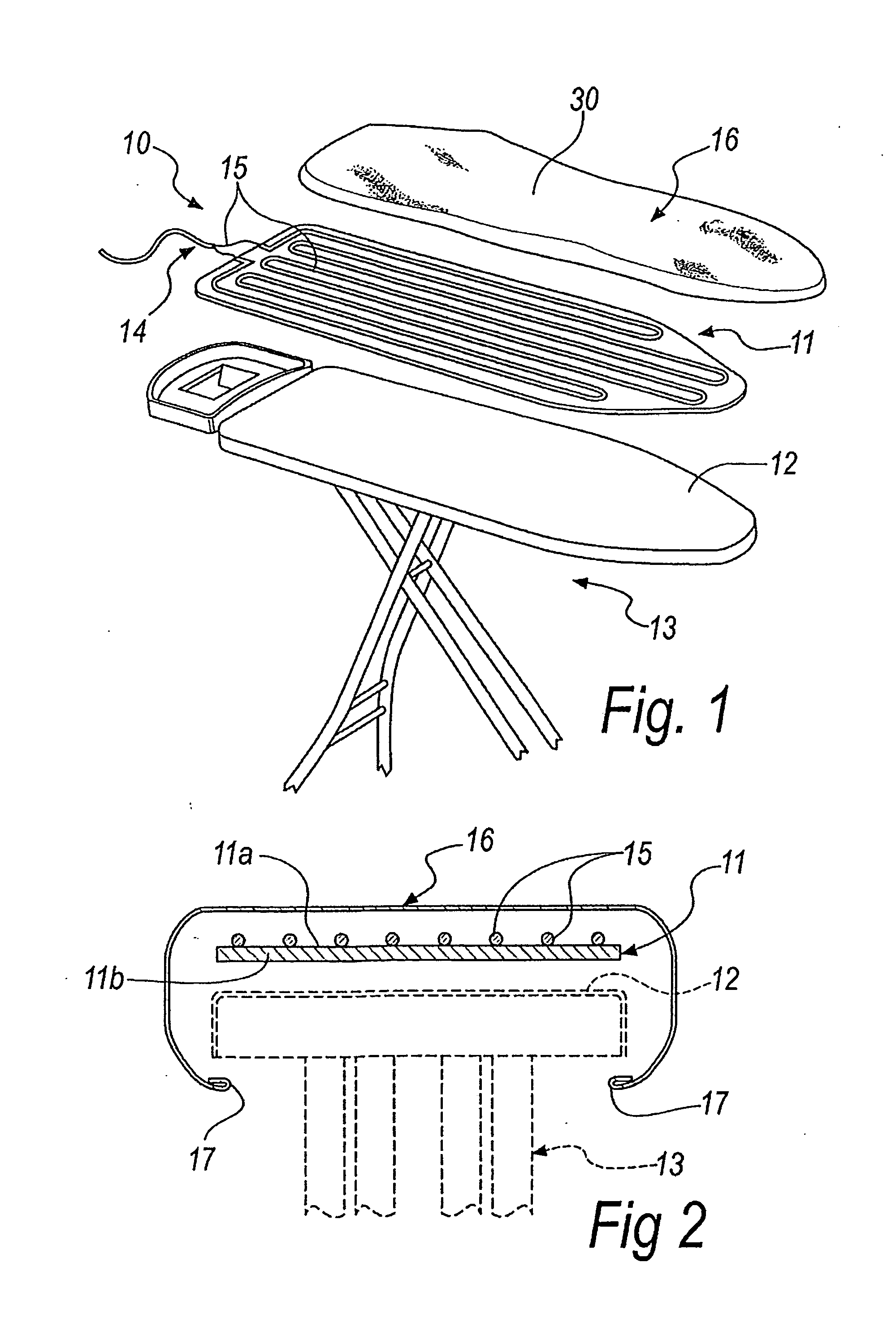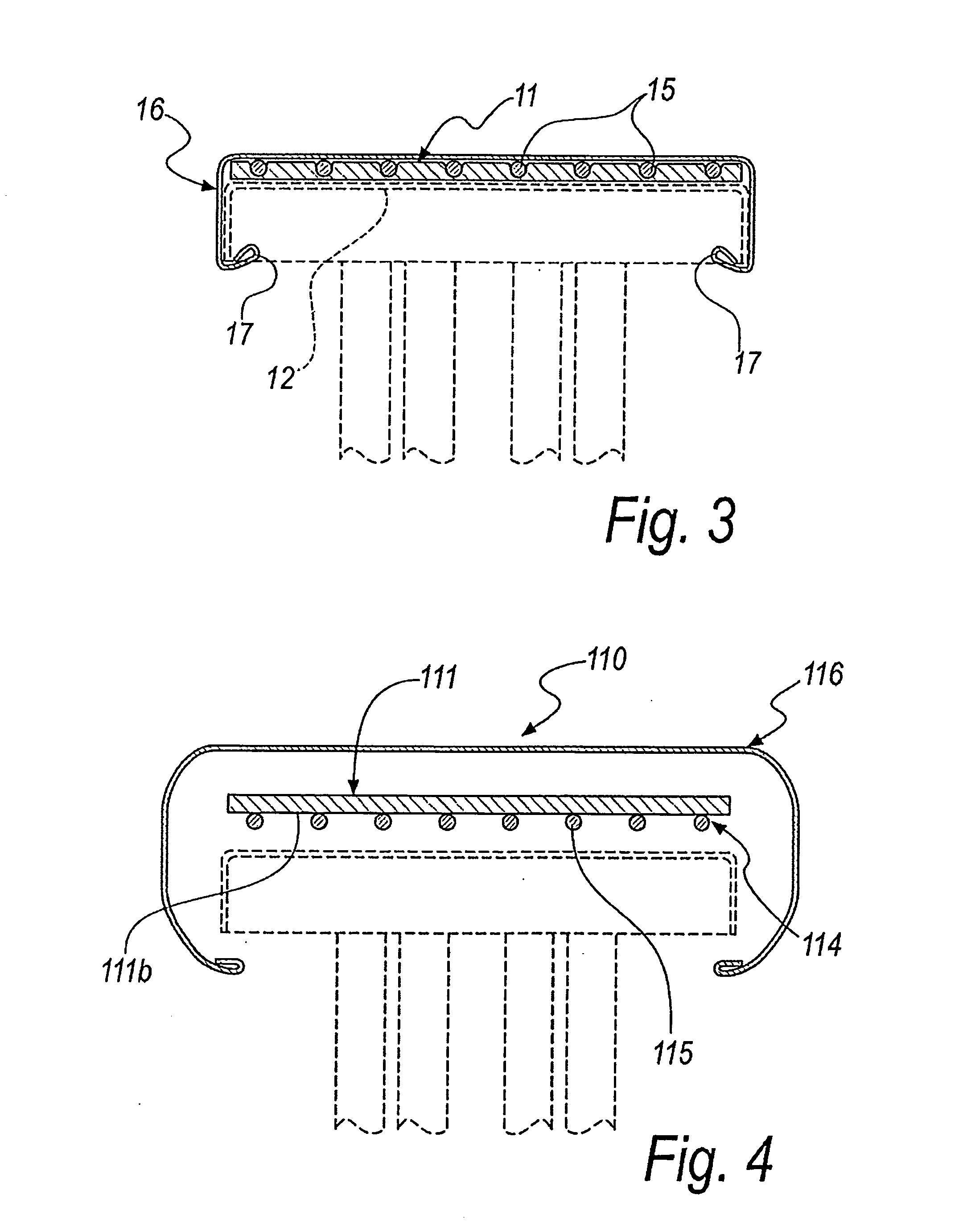Heating device for the ironing top of an ironing board
a heating device and ironing board technology, which is applied in the direction of ironing pads, washing machines, textiles and paper, etc., can solve the problems of inconvenient transportation, inconvenient heating, and inability to heat and dampen garments being ironed in a way that is entirely undesired, and achieves the effect of reducing the cost of production, and increasing the complexity of the heating system
- Summary
- Abstract
- Description
- Claims
- Application Information
AI Technical Summary
Benefits of technology
Problems solved by technology
Method used
Image
Examples
first embodiment
[0029]With reference to the figures, a heating device 10 for the ironing top of an ironing board, according to the invention, is indicated in its first embodiment with the reference numeral 10.
[0030]This heating device 10 comprises a flexible flat element 11, shaped to address an ironing top 12 of a generic ironing board 13.
[0031]In this first embodiment of the invention, the flexible flat element 11 is constituted by a flannel, i.e., by a sheet of plush cloth.
[0032]This flexible flat element 11 is provided with heating means 14, which are positioned so as to affect at least part of at least one of its main surfaces 11a and 11b.
[0033]In this first embodiment of the device 10, the heating means 14 are constituted by an electric heating cable 15, of a type that is known per se, distributed over the top surface, in a configuration of use, 11a.
[0034]The heating cable 15 is arranged for example in a coil as shown in FIG. 1.
[0035]In a different embodiment of the invention, instead of th...
second embodiment
[0040]In the device according to the invention, shown schematically by the cross-section in FIG. 4 and indicated therein with the reference numeral 110, the heating means 114, i.e. for example the heating cable 115, are arranged on the lower surface 111b of the flexible flat element 111.
[0041]In this position the planarity of the ironing surface of the cover 116, in a configuration of use, is improved.
third embodiment
[0042]FIGS. 5 and 6 show the heating device according to the invention, indicated therein with the reference numeral 210.
[0043]In the third embodiment, the flexible flat element 211, which carries the heating means 214 on its lower surface 211b, is associated with a second flexible flat element 220, shaped likewise and adapted to be interposed between the first flat element 211 and the ironing top 212, so as to improve the thermal insulation of the heating means towards the ironing top itself, which is generally made of metal.
[0044]The heating cable 215, or other similar element, is therefore sandwiched between the two flexible flat elements, which, for example, can both be flannels.
[0045]It should be noted that the second flat element 220 can also be made from other, similar and equivalent materials, according to necessity and requirements.
[0046]The sandwich comprising the first flat element 211 and the second flat element 220 is held against the ironing top 212 by the cover 216.
PUM
 Login to View More
Login to View More Abstract
Description
Claims
Application Information
 Login to View More
Login to View More - R&D
- Intellectual Property
- Life Sciences
- Materials
- Tech Scout
- Unparalleled Data Quality
- Higher Quality Content
- 60% Fewer Hallucinations
Browse by: Latest US Patents, China's latest patents, Technical Efficacy Thesaurus, Application Domain, Technology Topic, Popular Technical Reports.
© 2025 PatSnap. All rights reserved.Legal|Privacy policy|Modern Slavery Act Transparency Statement|Sitemap|About US| Contact US: help@patsnap.com



